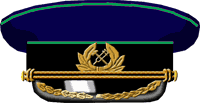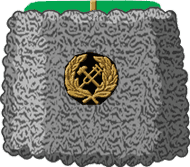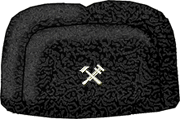Ranks of railway workers. The uniform of the railway workers in the post-war years
Rail transport in Ukraine is under the jurisdiction of the Ministry of Infrastructure. Like employees of other strategic state structures, Ukrainian railway workers received special symbols. Knowing how to "read", it will not be difficult to determine the rank, and with it the area of responsibility of a railway employee.
The list and design of the emblems of railway workers was approved by the Decree of the Cabinet of Ministers of Ukraine dated December 11, 1996 under No. 1508 "On signs of differentiation and uniforms of clothes for railway transport".
According to the current version of the document, the list of distinctive elements includes:
- emblem;
- designation of goods and services of Ukrzaliznytsia;
- technical sign;
- shoulder marks;
- collar embroidery;
- buttonholes;
- cockade.
The emblem of the Ukrainian railway is an image of a wheel located at some angle to the observer. Its vertical dimension is 18mm and horizontal is 8mm. Stylized wings with a span of 60 mm adjoin the wheel axles. The emblem is embroidered in golden color for the highest commanding staff and in the form of a metal badge for other employees.
The sign of the goods is a stylized letter UZ, placed in an arc that is about ¾ of the circle and passes into the side ledges. The image is given in gold on the required background. 
The technical mark is formed by a crossed hammer and adjustable wrench. 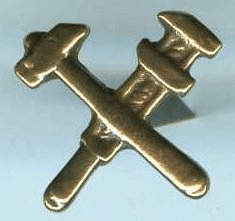
Individual positions are provided for appearance and a method of making emblems for caps, shoulder designations and buttonholes.
Insignia of the General Director of Ukrzaliznytsya and his deputies
The collar of the main ranks is decorated with embroidered laurel branches.
Shoulder badges are edged along the contour and fastened with a 15 mm button with a coat of arms.
For the General Director, two sprigs of laurel are embroidered in gold, above which is placed the Small Coat of Arms of Ukraine 4x2.4 cm in size. 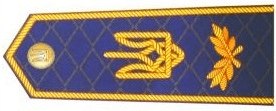
At the First Deputy, the laurel branches are closed in a circle, inside of which is five pointed star 25 mm in diameter. The trade symbol is placed in the upper zone. 
On the shoulder straps of the Deputy - the branches form a semicircle. 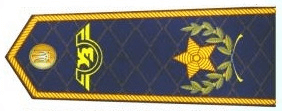
The cockade is an embroidery 100...165 mm wide and up to 50 mm high. 
Symbols of the highest commanding staff
The cockade is made of golden metal up to 3 cm wide and up to 4 cm high. The center of the composition is the coat of arms on a dark green background. 
Historically, transport industry workers in our country are used to distinguishing positions by sleeve patches. Flight personnel and ground services civil aviation did this almost at all times of their existence, as well as their colleagues - transport workers from the sea and river fleet. For railway workers in the period from 1926 to 1932 and from 1972 to 1994, the rank was also determined by the sleeve. And now there is a return to the system of sleeve distinction of workers by command staff.
Railroad insignia
Historically, belonging to a particular industry was determined by the metal emblem located below the button. The builders had it in the form of a bridge, the wagons had it in the form of a wagon, the locomotive workers had a steam locomotive, the movers had a traffic light, the signalmen were marked with crossed lightning bolts, and the hammer and sickle, superimposed on the French key and hammer, distinguished the administrative apparatus.
Men's summer uniform raincoat for conductors of branded trains, as well as drivers and assistant drivers of a high-speed train dark of blue color fabric blend
V new system Russian Railways insignia include galloons and stars of a special pattern. On the sleeves - a sign of regional affiliation: letter designation railway branch of Russian Railways. At the younger management team there is always a galloon, which was adopted at the end of the 19th century for civil officials. For middle-level commanders, stars are added to the galloon, and seniority is determined by their number.
The drawing of stars for Russian Railways was made specially. Senior managers are recognized by the wide galloon of a special pattern. The vice-presidents have vine leaves above the galloon (established by the “Regulations on civilian uniforms for civilian personnel Ministry of Railways” dated 1834) and braids are embroidered on the lapels of the collar. The main sign of belonging to the personnel of Russian Railways is a chevron, made in the form of an oval red contour shield on fabric of the color of objects uniform. Inside the shield is an emblem of stylized RZD letters in red. Chevron is designed to be worn on the left sleeve. The company logo is also on the uniform buttons. The development of signs for Russian Railways was carried out by the Heraldic Council under the President.
Current insignia
- Head of the railroad general manager) has a galloon of 30 mm and three stars of 25 mm in diameter.
- Dispatchers - galloon 15 mm and four stars.
- The head of the distance, railway station, depot, PMS, out-of-class and first-class stations - two galloons of 15 mm each and the same number of stars.
- Head of technical department of locomotives and wagons, attendants and masters - one galloon and two stars.
- 3rd class locomotive driver, wagon inspector, train compiler, senior ticket clerk - one galloon 15 mm wide.
The history of the development and introduction of a new uniform style
The new form was developed in accordance with the order of Russian Railways in 2010 in order to improve the image of the organization.
In April 2003, a competition was announced for the country's fashion designers who wanted to take part in it. A preliminary survey was conducted among railway workers who spoke in favor of abolishing the philosophy of militarism and the monopoly position of railway transport in a new corporate style.
In June 2006, the first show of samples of clothing, signs and accessories took place. The jury gave preference to the sketches of the Fashion House of Victoria Andreyanova (Moscow). And after working shows in 2006-2007, they were officially approved by the customer. The stage of designing and drawing up specifications has begun.
In 2009, operational tests were carried out on the Oktyabrskaya railway. In general, the clothes were approved, but comments were written, which were subsequently taken into account when the clothes were launched into mass production.
Corporate colors - blue, gray, silver, red.
Railroad uniform
Employees of the Ministry of Railways in pre-revolutionary Russia had 7 installation forms of uniforms - front, festive, ordinary, special, everyday, summer, road. The current upper winter and demi-season clothing(coat, raincoat, jacket) is issued to employees to wear for 4 years (for employees on company trains - for 3 years), the suit must be used for 2 years. Wearing a uniform is mandatory for all structural divisions, subject to direct participation in the organization of traffic and passenger service, and is purchased at the expense of Russian Railways itself.
Mixing uniforms with other uniforms is not allowed.
Railroad retirees may wear uniforms and insignia, which relied on them by status at the time of retirement.
In the post-war period, technical progress did not stand still, all the technical means of railway transport continued to develop, research, development and implementation of new designs were carried out. Great Patriotic War led to huge human and economic losses. One of the most important tasks was the training of young personnel for work in railway transport. But it was not enough to train young people, to give them specialties. 
The state undertook to provide them with preferential meals and uniforms. For many children of the military generation, this was simply vital. In 1946, the Ministry of Labor Reserves of the USSR developed a set of clothes for students of factory training schools, trade and railway schools. It included an overcoat, jacket, tunic, woolen dress for girls. Caps for boys served as headdresses, berets for girls. In winter, a hat with earflaps was relied upon.
June 12, 1954 goals Decree of the Presidium of the Supreme Soviet of the USSR "On the abolition of personal ranks and insignia for employees of civilian ministries and departments" was issued.
The uniform of the railroad workers has also undergone changes. by order No. 84/C dated September 9, 1955, shoulder straps were abolished and introduced the new kind uniforms with insignia in the form of buttonholes. Belonging to one or another type of railway service was determined by the color of the edging: for locomotive workers and wagon workers it was blue, for railway workers it was green, for signalmen it was platinum, for movers it was raspberry.
In essence, this order, prepared taking into account the changes taking place in the industry, meant a return to the pre-war uniform suit.
The uniform became different. The silhouettes of the suits were brought into line with the requirements of working conditions and fashion trends. The tunics were replaced by jackets, overcoats were replaced by coats. Blouses, blouses, shirts and ties appeared in everyday life. 
Order of the Ministry of Railways of the USSR No. 31 / Ts dated September 26, 1963 goals made changes to uniforms and insignia of railway workers.
In the same year, the emblem of railway transport was introduced in the form of an elliptical wheel with wings of four feathers shortened at the bottom. The emblem on the uniform for the higher composition was embroidered with a gilded cord, for the middle one - with a silver one. All other categories of railroad workers relied on a white metal emblem. She wore on right side chest, below the emblem there were signs about the end of educational institutions. 
To the higher, senior and middle composition of the roads of the Caucasus, Central Asia and the South were allowed to wear white summer uniforms.
Uniform suit of students of trade and railway schools, 1948.
Overcoat - black cloth, double-breasted with a fastener for five uniform buttons. The back of the overcoat is whole, with an opposite fold in the middle. On the sides of the back, at the level of the waist line, there is one curly column with buttons. A strap is fastened to the buttons of the columns. At the bottom of the back, in the middle there is a longitudinal slit - a slot. Turn-down collar with metal hook and loop closure.
At the ends of the collar, buttonholes are sewn with a piping of the established sample (light blue). The insignia of RU, ZHU and school number are pierced on the buttonholes. Sleeves are straight two-sutural. Overcoat lined to the waist. At hissed for boys, one chest pocket is closed on the left shelf. At the overcoat for girls, the breast pocket is closed on the right shelf.
Jackets- black cloth, double-breasted on the vaga, with a fastener on the side with four light metal buttons and four loops, one of which is on the lapel. Turn-down collar, fastened with a metal hook and loop. Buttonholes are sewn on the collar of the jacket with the designation for vocational schools - "RU No.", for railway schools - "ZHU No.". Buttonholes made of black cloth with a light blue edging are sewn on the ends of the collar. Welt side pockets with flaps. The back has a figured yoke, stitched in the middle, has a strap and two tucks along the waistline. Sleeves are straight two-sutural.
tunic- dark blue diagonal Before the tunic with a slit, patched straps, and with one chest pocket on the left side. Overhead pocket, adjustable, without valve. The collar is standing, two-layer, fastened with two buttons and two loops. The sleeves are single-seam, with two folds at the bottom and with cuffs fastened with two buttons and two through loops. Buttons are shaped, with a key and a hammer. 
The dress- black cashmere With a cut-off bodice, a fastener in front to a waist line on four uniform buttons. Turn-down collar, trimmed with an upper collar made of white fabric. The sleeves are single-seam, at the bottom with cuffs, fastened with one uniform button. The skirt of the dress is flared down, has four pleats in front and two pleats in the back. The side folds of the front of the skirt have undercuts at the top, into which pockets are closed. A belt runs along the waist of the dress, fastened in front with one uniform button.
Cap- black cloth, consists of an oval-shaped bottom, a crown of four arched quarters and a straight whole band. The front of the cap is made straight, with a slightly convex crown on a semi-rigid stand. The cap has an edging of the established color. The visor is fibre, black, varnished on both sides. Above the visor is a lacquered strap with loops, attached at the ends to two small shaped metal buttons. On the front band, above the lacquered strap, a uniform badge is attached.
Beret(for girls) - cloth, lined, consists of a whole bottom and two barrels stitched together. A uniform badge is attached to the front of the beret. It is allowed to wear instead of a cloth felt beret without lining.
The hat with earflaps is sewn from black cotton cloth and consists of a four-wedge cap with earmuffs covered with gray artificial fur.
The visor of the hat, covered with faux fur, is attached to the cap with two paper clips. A shaped badge is attached to the center of the visor. Headphones are tied with a cotton braid in the color of the fabric.
Overalls working cotton, in front fastened to the top with six through loops and six buttons. Patch pockets are sewn on the front halves at a distance of one centimeter from the side seams. The back is whole with a seam in the middle. Jumpsuit at the waist with a belt attached to the middle seam of the back with machine stitching, fastening at the front with a button and loop. Turn-down collar, no hook and loop. The sleeves are straight, ending at the bottom with cuffs fastened with one loop and a button. Low-cut trousers with cuffs fastened with one loop and a button. 
Uniform suit and insignia of railway workers, 1955
Caps served as a headdress in summer, in winter - a hat with earflaps made of black astrakhan fur and blue cloth.
Set uniform included: a tunic in dark blue or light brown, fastened with five uniform buttons, with a turn-down collar and two breast pockets with flaps; trousers in the color of the tunic, worn loose, without piping and cuffs.
The outerwear was a double-breasted overcoat with five buttons on the side. At the higher staff, a gilded technical badge was attached to the cap in a wreath and filigree above the visor of a golden thread. The edges of the buttonholes were edged with a gilded cord. On the black velvet field of buttonholes, a technical sign from one to three stars, each 20 mm in size, was embroidered with gold thread.
The senior staff on the cap relied on filigree and a technical sign. On the field of buttonholes there were two longitudinal silver-plated gaps, a metal technical sign and from one to three stars, 15 mm each.
All the rest had a technical badge on their caps on their headdresses, instead of filigree - a black lacquered strap.
buttonholes in the middle composition they had one clearance, a technical mark and, to a sin, stars, each 12 mm in size. The field of buttonholes of the junior team is smooth, with a technical sign and metal corners up to five pieces.
For machinists, on the buttonholes under the technical sign, across the buttonhole, the emblem of the locomotive was attached, from the emblem, along the buttonholes, white stripes were sewn according to the class of the driver (first class - three, second - two). On the driver's cap, along the upper edge of the band, there was a white silk braid. 
Uniform suit and insignia of railway workers, 1963
Rank insignia in the form of buttonholes replaced sleeve patches. A single color for the edging was established for all services - green. For personnel black approved winter clothes and light gray for summer. The set of uniforms for men included coats, winter and summer suits.
Coat It was double-breasted, with a fastened insulating lining, two side welt pockets with flaps.
Winter suit consisted of a double-breasted jacket with open lapels, two side welt and one breast pockets and trousers that were supposed to be worn without cuffs, loose.
The cut of the summer suit corresponded to the winter suit, only the jacket was single-breasted. Certain categories of workers were also entitled to a single-breasted jacket, closed, with a turn-down collar, two welt side and one breast pockets.
A blouse-shirt was worn under the jacket, the bottom of which ended with a belt. A black narrow tie was required.
Cap- in the color of the suit, had a black band, a black lacquered visor. A green piping ran along the upper edge of the crown and band. A gilded technical badge in a wreath was attached to the cap band of the senior staff, and an embroidered gilded emblem of railway transport relied on the crown. Silver embroidery was installed for the senior staff. The rest of the categories of workers were given a metal sign on the band, and a white metal emblem on the crown.
The caps were attached with a visor: the highest composition had a wicker gilded filigree, the senior one had a silver one, and all the others had a black lacquered strap.
The upper edge of the band of the driver's cap was decorated with white silk galloon. On the cap of the main conductor above the visor, instead of a varnished strap, a braided red cord was attached.
For the winter, a hat with earflaps was provided: for the highest commanding staff - from gray astrakhan fur, senior and middle - from black astrakhan fur, for the rest - from tsigeyka or faux fur black color. The order of fastening the device is the same as on the cap. 
Uniforms for women included a suit (winter and summer), consisting of a single-breasted jacket with open lapels, two side slits and one chest pocket, and a skirt with a one-sided pleat at the back. Separate categories of workers, in addition, relied on a single-breasted jacket with a turn-down collar and a skirt extended downwards.
The headdress was a beret according to the color of the suit. A technical sign was attached to the beret, above it - the emblem of the railway transport.
Buttons on coats, jackets, jackets and jackets: for the highest commanding staff - gilded with the image of the coat of arms Soviet Union, the rest of the employees - white metal with the image of a technical sign.
were used as insignia sleeve patches: in the form of a rectangle - for a higher composition with a size of 100 x 75 mm; medium - 100 x 55 mm; for the junior and private - in the form of a pentagon with a width of 40 at the base, 110 at the top and a height of 70 mm. The field of sleeve insignia was made from the same fabric as the clothes on which they were sewn.
The upper edge of the sleeve insignia was edged: for the senior staff - with gilded cord, for the senior - with a silver-plated cord, for the middle - with green cloth. Sleeve insignia junior and enlisted personnel were edged with green cloth on all sides of the pentagon. Edge width 3 mm. The sleeve badges were sewn on both sleeves at a distance of 80 mm from the bottom of the sleeve. 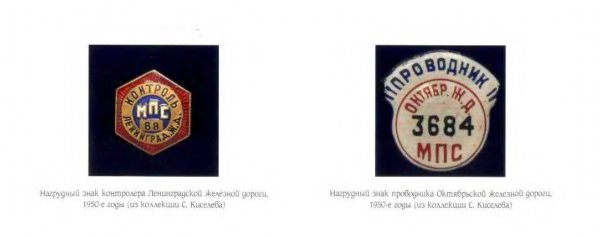
On the field of sleeve insignia:
a) the highest commanding staff - the Minister of Railways and the First Deputy Minister of Railways - a gold-colored galloon 60 mm wide was sewn on. In the center of the field was located: at the Minister of Railways - the coat of arms of the Soviet Union 45 mm in size, at the first deputy - a star 40 mm in size against the background of radiant diverging lines. For the rest of the higher composition, transverse stripes of golden galloon 10 mm wide were sewn in numbers from one to four. In the upper part of the field, stars 20 mm in size were embroidered with gold, corresponding to the number of stripes;
b) the senior commanders were sewn on transverse stripes of silver galloon 10 mm wide from one to four (according to the report card approved by the Minister of Railways of the USSR on October 26, 1963), white metal stars 15 mm in size were attached to the upper part of the zero, according to the number of stripes;
c) the middle commanding staff were placed strips of silver galloon 6 mm wide (up to four) and stars 10 mm in size;
d) the junior commanding staff had a pentagon-shaped patch with a white metal technical badge in the upper part and green stripes (from one to four) in the lower part;
k) the rank and file on the stripes had one white metal technical sign. 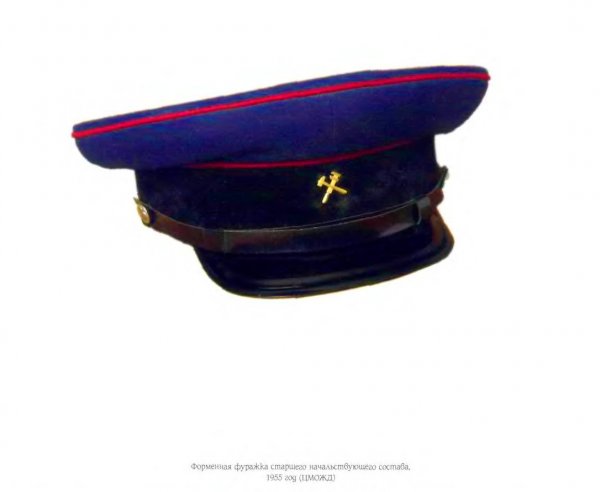
In the higher, senior and middle squads, a pentagon was attached 30 mm above the patch, made of the same fabric as the clothes, 20 mm wide at the base and 45 mm high. In the center of the pentagon there is a technical sign, embroidered: for the higher staff - with a gilded cord, and for the senior one - with a silver-plated cord. All sides of the pentagon were edged with a silver-plated or gilded cord, according to the technical mark. The pentagon of medium composition was edged with green cloth
Hello dear.
I don’t know about you, but I personally use such a mode of transport as the metro every day and many times. I'm used to it, it's convenient for me and saves a lot of time. Descending and descending repeatedly into the subway, I constantly pay attention to such a simple and ordinary thing as the shoulder straps of metro workers. Did you pay attention to them?
A question may arise - why, in fact, do metro workers wear epaulettes? They are something akin law enforcement and armies? Good question. Not related. But at the same time, the metro is a strategic object that is guarded like the apple of an eye, and since the metro previously belonged to the system of the railway department, the uniform and insignia should not surprise you.
I want to immediately warn you - I'm just studying the issue, and I'm not at least some kind of specialist in the subject. I'm just studying. This is why - if I made any mistakes - I ask you not to throw rotten kiwis, but to correct or supplement interesting and correct information.
So, as far as I understood and found out, in the metro shoulder straps are connected not with ranks, as in paramilitary organizations, but with positions. All positions in the metro can be divided into 5 unequal parts.
Ordinary, junior, middle, senior and senior commanding staff.
For example, an ordinary person in the track service includes, for example, a track fitter for servicing turnouts or a tracker and a contact rail. They correspond to the assistant driver. And their shoulder strap is like this:
By the way, shoulder straps come in different colors:
White - dress shirt
Light Blue - Casual Shirt
Dark blue - tunic and jacket with a zipper.
Next we have the junior team. This is the adjuster of the track measuring and flaw detection car, for example. Or a driver without a class or a driver of the 3rd class:
Followed by - average composition. This is the Senior foreman of the districts (sections) of the path or the Senior foreman for the current and overhaul way. This also includes the Machinist of the second or first class, who, in addition to working on the line, is allowed to run in and ferry between depots. Here are the shoulder straps:
As far as I understand, the driver-instructor also belongs to the average composition. Driver-Instructor - is engaged in monitoring the work of the driver on the line, as well as instructing those who intercede, etc. etc.:
Next we have the senior command staff.
It can be attributed to the Deputy head of the depot, head different services in the depot - repair, operation. Also the chief engineer of the depot. Shoulder straps are like this:
Head of the distance, head of the depot or head of the department:
Next we have the highest commanding staff. It all looks like this. But I've never seen anything like it.
Have a nice time of the day.
On June 12, 1954, the Decree of the Presidium of the Supreme Soviet of the USSR “On the abolition of personal ranks and insignia for employees of civilian ministries and departments” was issued. Behind him almost a year later, i.e. On September 3, 1955, the Decree of the Council of Ministers of the USSR No. 1624 “On uniforms and insignia for railway personnel” followed.
" The Council of Ministers of the USSR decides:
1) Accept the proposal of the Ministry of Railways to change the uniform and introduce new insignia in accordance with the Decree of the Council of Ministers of the USSR of July 6, 1954 No. 1390 for railway personnel directly related to train traffic, passenger service and cargo transportation in accordance with Annexes No. 1 and 2.
2) Establish a discount on the cost of uniforms for senior and middle commanding officers whose official salaries do not exceed 1,100 rubles per month in the amount of 20% of the cost, and for private and junior commanding officers who receive free overalls (except for locomotive drivers) - in in the amount of 40% of the cost and for those who do not receive free overalls - 50% of the cost.
3) Provide installment payment for the cost of uniforms to juniors and privates for the period of wear, and to other employees - for 1 year.
4) To oblige the Minister of Railways to approve within two weeks the table of positions of the personnel of the railway transport for receiving uniforms and insignia, as well as to establish the procedure and deadlines for the transition to a modified form, the procedure for introducing insignia.
5) To oblige the Ministry of Industrial Consumer Goods of the USSR to ensure the manufacture of fabrics for uniforms of railway transport personnel and the supply of these fabrics to the Ministry of Railways, starting from October 1955, and also to develop and, in agreement with the Ministry of Railways, approve the technical conditions for the manufacture of uniforms for railroad personnel.
Appendix No. 1 to Decree of the Council of Ministers of the USSR of September 3, 1955 No. 1624 described uniforms and insignia for railway personnel directly related to train traffic, passenger service and cargo transportation.
I) Uniform.
The uniform of the personnel of the railway transport consists of the following items:
The tunic is single-breasted with a turn-down collar, fastened with one hook and 5 metal buttons with the image of a technical sign on them, located in one row, with two upper welt pockets with flaps.
The buttons of the tunic, jacket, overcoat and coat of the highest commanding staff are gilded with the image of the coat of arms of the Soviet Union. For the highest, senior and middle commanding staff, the tunic is made: in winter - from dark blue woolen fabric, in summer - from light gray woolen fabric, additionally white tunic - for the highest commanding staff from silk fabric, for senior and middle - from cotton , linen or staple fabric.
For junior commanding officers and rank and file: winter - from dark blue cloth, summer - from cotton fabric dark blue.
Tuzhurka - for the highest commanding staff of the Ministry apparatus - double-breasted, without piping, with open lapels, welt transverse pockets in the margins and one chest pocket with six buttons, three in a row. When wearing a jacket, a white or light gray shirt is worn with a black silk tie. When leaving the line, the highest commanding staff of the apparatus of the Ministry of Railways is allowed to wear a tunic.
Trousers - loose without fringing and smears - from the same fabric as the tunic and jacket.
Overcoat - double-breasted of dark blue drape or cloth with two rows of metal buttons. For the highest commanding staff, it is edged with light green cloth.
Summer coat - for the highest commanding staff, double-breasted of light gray fabric.
Raincoat coat - for the senior commanding staff of rubberized woolen fabric, for the middle commanding staff of rubberized cotton fabric in dark blue.
Cap - from the fabric of the corresponding fabric of the tunic with a black velvet band - for the highest, senior and middle commanding staff and cloth - for the rest. Caps are edged with cloth according to the service. A technical sign is attached to the band of the cap. An embroidered gilded technical sign in a wreath and a gilded filigree are attached above the visor of the cap of persons of the highest commanding staff, the visor is framed with embroidered oak leaves. For the senior commanding staff, a silver filigree is attached above the visor, and the cap of the rest of the workers is with a lacquered strap.
|
|
|
|
|
|
Cap of the highest composition |
Senior cap |
Cap of the middle and junior staff. |
Engineer's cap |
|
|
|
|
|
|
Cap of the main conductor |
Hat of the highest composition |
Hat with ear flaps |
Women's beret |
On the driver's cap, on the upper edge of the band below the piping, a white silk galloon is sewn.
Instead of a varnished strap, a braided red cord is attached to the cap of the main conductor.
Papakha - from black astrakhan for the highest commanding staff with a light green cloth top, on which there is a cross-shaped galloon embroidered with gold.
Hat - earflaps - for senior, middle, junior commanding staff and privates from black astrakhan and cygkey. A technical sign is attached to the front in the center of the papakha and earflaps.
II) Uniforms for women
Dress with a turn-down collar, fastening with one hook and 4 metal buttons, with two chest welt pockets and a belt.
The skirt is six-seam with two side pockets.
The dress is made: for the highest, senior, middle, junior commanding staff and rank and file, winter - from dark blue woolen fabric, summer for persons of higher, senior commanding staff - from light gray woolen fabric, for middle, junior commanding and private composition - from white cotton, linen or staple fabrics.
Overcoat and raincoat - the established sample.
Summer headdress - takes the color of the dress, winter - hat - earflaps.
III) Insignia
1) Badges of distinction are established according to the official sign.
The insignia are the buttonholes on the collars of the overcoat, summer
Coat, raincoat, jacket, tunic and dress.
Buttonholes are a rectangle with beveled ends
10 cm long and 3.3 cm wide with piping.
2) Buttonholes are made for the highest, senior and middle commanding staff from black velvet, and for the rest of the workers - from black cloth.
b) the first deputies of the Minister of Railways - a technical badge embroidered in gold in a laurel-oak wreath and below its star against the background of radially diverging lines 25 mm in size;
c) Deputy Ministers - a technical badge embroidered with gold and 4 stars 20 mm each;
d) members of the board of the Ministry of Railways - a technical sign embroidered with gold and 3 stars 20 mm in size each;
e) the rest of the senior commanding staff of railway transport - a technical sign and a star from 1 to 3 20 mm in size embroidered in gold;
f) senior commanding officers - two longitudinal silver-plated twisted cords 3 mm wide each, a technical badge and white metal stars from 1 to 3, 15 mm each;
g) middle command staff - one silver-plated twisted cord 3 mm wide, technical badge and white metal stars from 1 to 3, 12 mm each
4) Longitudinal stripes or squares are sewn on the field of buttonholes of junior commanding officers and rank and file; on the buttonholes of locomotive drivers, under the technical sign, a metal steam locomotive emblem is placed.
5) On the buttonholes of railway workers who are not entitled to insignia, only a technical badge is attached.
Editorial notes: 1. The size of the metal technical sign is 15 mm (20 mm diagonally).
2. In addition to the emblem-locomotive, there was an emblem-electric locomotive. Emblems were found in both white and yellow metal (possibly old linear ones). Signs were also worn by assistant drivers and stokers.
The Decree of the Council of Ministers of the USSR was confirmed by the Order of the Minister of Railways No. 84Ts of September 9, 1955 "On uniforms and insignia for personnel of railway transport", where the Decree of the Council of Ministers of the USSR of September 3, 1955 was adopted for guidance and execution, and also cited black and white drawings of new uniforms and insignia. Translation into new form clothing and insignia was to be completed in the first half of 1956, for which the Deputy Minister Gundobin was instructed to submit for approval the report card of the personnel of the railway transport for approval. The report card was approved by the Order of the Minister of Railways of the USSR No. 91Ts of September 28, 1955. It was a list of positions of railway workers, "directly related to the movement of trains, passenger service and transportation of goods." The list included positions for the services that were part of the department and department, railways. The notes stated:
“1) The highest, senior and middle commanding staff are allowed to wear boots and trousers - a bridge.
2) The highest, senior and middle commanding staff of the roads of the Caucasus, Central Asia and the South are allowed to wear white trousers with white tunics.
3) For hats, shoes, buttonholes and insignia, the wearing period is not established, since they are purchased by employees for cash in the trading network.
- Menu for a month of body drying for girls
- Learning to perform an extension of the arms on the block
- How to treat the liver in adults: a list of effective drugs
- How to meet a girl
- How to pump up the press at home
- Training the rear deltas on the horizontal bar
- Is it possible to pump up the chest on the horizontal bar: an overview of effective exercises
- Recovery after dislocation of the shoulder joint: exercises, massage
- Shoulder exercises at the gym
- Drying the body: menu, stages and rules of nutrition
- What country did the ice cream come from
- The rainforest is a very special forest.
- Lecture: Structure and water masses of the World Ocean Topic "Horizontal structure of the waters of the World Ocean"
- How do Anglicans pray with two or three fingers?
- What is Anglicanism definition
- Methods for determining the coordinates of the center of gravity How to determine the center of gravity of irregularly shaped bodies
- The positions of the center of gravity of some figures How to find the center of gravity of a circle with a hole
- About the "winter" king, the beautiful princess and their castle
- How to create a rainbow at home - presentation
- Why is biology needed?

